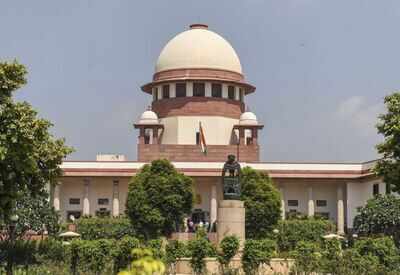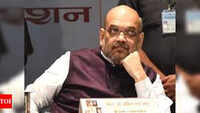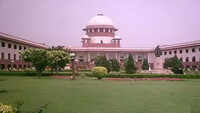
A three-judge SC bench imposed a Re 1 penalty on lawyer-activist Prashant Bhushan for contempt of court for his tweets that were critical of the SC and some of its judges.
On August 14, the Supreme Court found Bhushan guilty of contempt for two tweets targeting the judiciary and Chief Justice S A Bobde. Bhushan, given a chance to apologise, refused, saying the tweets represented his “bonafide beliefs” and an apology would be insincere.
Bhushan has been asked to deposit the penalty amount by September 15. He will have to face 3-month imprisonment and also debarred from practice for 3 years for failure to deposit penalty amount, the court said.
But what exactly is contempt of court?
Broadly, it is any action that brings a court into disrepute — in this case the SC felt Bhushan’s tweets attempted to scandalise the entire institution of the Supreme Court. A person can also be in contempt of court if one deliberately refuses to comply with a court’s judgment. Subrata Roy of Sahara was held guilty for this.
The Contempt of Courts Act was passed in 1971. In 2006, the government brought in an amendment, allowing ‘truth’ as a defence. The punishment for contempt is up to six months in jail or a fine of Rs 2,000, or both.
Live: SC fines Prashant Bhushan Re 1 for contempt of court
Why does SC say Bhushan’s remarks are in contempt?
On July 22, the SC initiated suo motu contempt proceedings against Bhushan for two of his tweets. In one, he had posted a photo of CJI Bobde seated on a Harley Davidson bike during lockdown. In another tweet, Bhushan claimed the SC under the last four CJIs had played a role in the “destruction of democracy”. On August 4, the court also raked up a 2009 interview Bhushan had given to Tehelka, where he claimed “half of the 16 former CJIs were corrupt”, and asked the lawyer to apologise. (The judgment for this case has been deferred.)
The Supreme Court said Bhushan’s remarks “(undermined) the confidence of the public in the judiciary” and could have an adverse impact on the administration of justice. Though the apex court said criticism of judges, made in the interest of the public, does not constitute contempt, it asserted that vilification of a judge is a form of ‘scandalising’ the court. The court also said motives should not be attributed to judges as they cannot defend themselves publicly and “can only speak through judgments”.
What was Bhushan’s defence?
Bhushan’s arguments focused on procedural lapses and the intentions behind his tweets. He said that the petition bringing his tweets to the SC’s attention was not approved by the attorney general, as is procedurally required. Instead, it was placed directly before the court. The apex court, however, dismissed this argument saying it was exempted from this administrative process by the court.
Bhushan said the tweets themselves were made in public interest. He said the photograph of CJI Bobde showed him in a public place surrounded by people in violation of the lockdown rules at a time when the Supreme Court was not operating normally because of the risks posed by the pandemic. He defended his comments on the cost of the motorcycle and that it belonged to a BJP leader, saying the details had been widely publicised on social media. He, however, regretted saying the CJI was riding the bike when, in fact, Bobde was only seated on the stationary bike.
In his tweet criticising the role of the SC in the “destruction of democracy”, he listed several pending cases including petitions against the abrogation of J&K’s special status and the Citizenship Amendment Act, contrasting them with the smooth proceedings in the Ayodhya land dispute case.
What do India’s contempt laws mean for free speech?
Freedom of speech was raised as a concern when contempt of court was added to the Constitution in 1949. While a number of lawmakers said contempt of court was a necessary power of the judiciary, others said contempt laws are prone to abuse and could restrict freedom of speech guaranteed as a fundamental right because judges simultaneously act as the prosecutor and victim.
More than 3,000 former judges, retired bureaucrats, journalists and lawyers have signed a statement condemning the Supreme Court’s decision to convict Bhushan, calling it a “disproportionate response” that could limit the expression of valid criticism of the judiciary. Many rights groups and political leaders have called for reforms to contempt laws.
What do contempt laws look like around the world?
Though many democracies have some form of contempt laws in place, criminal contempt of court has either been removed or is generally not pursued.
In 1987, when the UK’s Daily Mirror referred to members of the House of Lords as “old fools” over a judgment in the Spycatcher publication case, the House refused to hold the newspaper in contempt, saying its remark was a matter of perception. In 2013, the UK abolished “scandalising” the court as an offence, saying it restricts the freedom of speech. When the Daily Mail called three judges “enemies of the people” over a Brexit ruling in 2016, the court refused to pursue contempt proceedings. The last time the UK enforced its contempt laws was in 1930.
In the US, Canada and Australia, contempt laws are used only if there is an imminent and clear threat to the administration of justice. Legal experts have said contempt laws cannot effectively be used to garner respect for courts and protect them from scrutiny. Judges from these countries have also said courts, as public institutions, must be open to criticism.
On August 14, the Supreme Court found Bhushan guilty of contempt for two tweets targeting the judiciary and Chief Justice S A Bobde. Bhushan, given a chance to apologise, refused, saying the tweets represented his “bonafide beliefs” and an apology would be insincere.
Bhushan has been asked to deposit the penalty amount by September 15. He will have to face 3-month imprisonment and also debarred from practice for 3 years for failure to deposit penalty amount, the court said.
But what exactly is contempt of court?
Broadly, it is any action that brings a court into disrepute — in this case the SC felt Bhushan’s tweets attempted to scandalise the entire institution of the Supreme Court. A person can also be in contempt of court if one deliberately refuses to comply with a court’s judgment. Subrata Roy of Sahara was held guilty for this.
The Contempt of Courts Act was passed in 1971. In 2006, the government brought in an amendment, allowing ‘truth’ as a defence. The punishment for contempt is up to six months in jail or a fine of Rs 2,000, or both.
Live: SC fines Prashant Bhushan Re 1 for contempt of court
Why does SC say Bhushan’s remarks are in contempt?
On July 22, the SC initiated suo motu contempt proceedings against Bhushan for two of his tweets. In one, he had posted a photo of CJI Bobde seated on a Harley Davidson bike during lockdown. In another tweet, Bhushan claimed the SC under the last four CJIs had played a role in the “destruction of democracy”. On August 4, the court also raked up a 2009 interview Bhushan had given to Tehelka, where he claimed “half of the 16 former CJIs were corrupt”, and asked the lawyer to apologise. (The judgment for this case has been deferred.)
The Supreme Court said Bhushan’s remarks “(undermined) the confidence of the public in the judiciary” and could have an adverse impact on the administration of justice. Though the apex court said criticism of judges, made in the interest of the public, does not constitute contempt, it asserted that vilification of a judge is a form of ‘scandalising’ the court. The court also said motives should not be attributed to judges as they cannot defend themselves publicly and “can only speak through judgments”.
What was Bhushan’s defence?
Bhushan’s arguments focused on procedural lapses and the intentions behind his tweets. He said that the petition bringing his tweets to the SC’s attention was not approved by the attorney general, as is procedurally required. Instead, it was placed directly before the court. The apex court, however, dismissed this argument saying it was exempted from this administrative process by the court.
Bhushan said the tweets themselves were made in public interest. He said the photograph of CJI Bobde showed him in a public place surrounded by people in violation of the lockdown rules at a time when the Supreme Court was not operating normally because of the risks posed by the pandemic. He defended his comments on the cost of the motorcycle and that it belonged to a BJP leader, saying the details had been widely publicised on social media. He, however, regretted saying the CJI was riding the bike when, in fact, Bobde was only seated on the stationary bike.
In his tweet criticising the role of the SC in the “destruction of democracy”, he listed several pending cases including petitions against the abrogation of J&K’s special status and the Citizenship Amendment Act, contrasting them with the smooth proceedings in the Ayodhya land dispute case.
What do India’s contempt laws mean for free speech?
Freedom of speech was raised as a concern when contempt of court was added to the Constitution in 1949. While a number of lawmakers said contempt of court was a necessary power of the judiciary, others said contempt laws are prone to abuse and could restrict freedom of speech guaranteed as a fundamental right because judges simultaneously act as the prosecutor and victim.
More than 3,000 former judges, retired bureaucrats, journalists and lawyers have signed a statement condemning the Supreme Court’s decision to convict Bhushan, calling it a “disproportionate response” that could limit the expression of valid criticism of the judiciary. Many rights groups and political leaders have called for reforms to contempt laws.
What do contempt laws look like around the world?
Though many democracies have some form of contempt laws in place, criminal contempt of court has either been removed or is generally not pursued.
In 1987, when the UK’s Daily Mirror referred to members of the House of Lords as “old fools” over a judgment in the Spycatcher publication case, the House refused to hold the newspaper in contempt, saying its remark was a matter of perception. In 2013, the UK abolished “scandalising” the court as an offence, saying it restricts the freedom of speech. When the Daily Mail called three judges “enemies of the people” over a Brexit ruling in 2016, the court refused to pursue contempt proceedings. The last time the UK enforced its contempt laws was in 1930.
In the US, Canada and Australia, contempt laws are used only if there is an imminent and clear threat to the administration of justice. Legal experts have said contempt laws cannot effectively be used to garner respect for courts and protect them from scrutiny. Judges from these countries have also said courts, as public institutions, must be open to criticism.
Download
The Times of India News App for Latest India News

Coronavirus outbreak
Trending Topics
LATEST VIDEOS
India
 Union Home minister Amit Shah discharged from AIIMS
Union Home minister Amit Shah discharged from AIIMS  Major clashes between security forces and locals in Srinagar's Zadibal
Major clashes between security forces and locals in Srinagar's Zadibal  India’s 1st female cardiologist dies of Covid at 103
India’s 1st female cardiologist dies of Covid at 103  Hopeful of privatising Air India in 2020, says Civil Aviation Minister
Hopeful of privatising Air India in 2020, says Civil Aviation Minister  Unlock 4.0: Haryana to follow Centre rules, markets can function on all seven days now
Unlock 4.0: Haryana to follow Centre rules, markets can function on all seven days now  99% of Supreme Court lawyers opposed to physical hearing
99% of Supreme Court lawyers opposed to physical hearing
More from TOI
Navbharat Times
Featured Today in Travel
Quick Links
Coronavirus in MumbaiCoronavirus in KolkataCoronavirus in HyderabadCoronavirus in DelhiCoronavirus in BangaloreCoronavirus symptomsCoronavirus in IndiaWhat is CoronavirusCoronavirus NewsSolar EclipseNPRWhat is NRCCAB BillCAB and NRCRTI BillPodcast newsLok SabhaShiv SenaYSRCPCongressBJP newsUIDAIIndian ArmyISRO newsSupreme Court
Get the app



